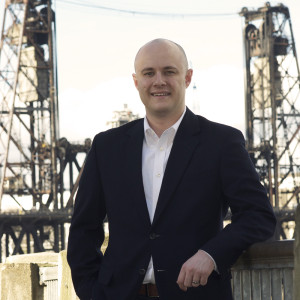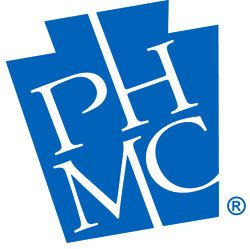The Pennsylvania State Historic Preservation Office has multiple roles and frequently has many irons in the fire. Among the responsibilities that people are most familiar with are facilitating National Register nominations, assisting tax credit applicants, managing grants, advising community leaders, reviewing state and Federally-assisted project, and maintaining historical markers. But from time to time, the office has the opportunity to delve into other projects and issues that will help Pennsylvania’s communities better preserve and enhance historic places. There are a number of special projects underway right now and two new staff members, Jeremy Young and Shelby Weaver-Splain, have recently come aboard to manage these programs.
Jeremy and Shelby joined the PaSHPO staff in July 2014 and I asked each of them to share a little bit about their backgrounds, interests, and projects.
Jeremy Young
 Jeremy is the Hurricane Sandy Recovery Project Manager and is leading the PaSHPO’s efforts to rehabilitate historic properties damaged by the storm, integrate historic preservation interests into county and state hazard mitigation plans, and provide training opportunities about disaster planning in historic environments. He is a native of Lancaster, Pennsylvania, earned a Bachelor’s degree in Geography from Millersville University, and recently returned to the Keystone State after spending two years in Portland, Oregon where he earned his Master of Urban and Regional Planning degree from Portland State University.
Jeremy is the Hurricane Sandy Recovery Project Manager and is leading the PaSHPO’s efforts to rehabilitate historic properties damaged by the storm, integrate historic preservation interests into county and state hazard mitigation plans, and provide training opportunities about disaster planning in historic environments. He is a native of Lancaster, Pennsylvania, earned a Bachelor’s degree in Geography from Millersville University, and recently returned to the Keystone State after spending two years in Portland, Oregon where he earned his Master of Urban and Regional Planning degree from Portland State University.
In between college and graduate school Jeremy worked with the Lancaster County Planning Commission, James Street Improvement District/Downtown (Lancaster) Improvement District Authority, and spent a summer as a THIS (The Harrisburg Internship Semester) intern in the PaSHPO office. In Portland, Jeremy was a research assistant at the Institute of Portland Metropolitan Studies and Population Research Center, a land use and transportation intern at the Port of Portland, and urban planner at Watermark Planning. He’s now living in Midtown Harrisburg with his wife Melissa, newborn son Everett, and poodle-American Eskimo mix Charlie.
- What attracted you to this position and what aspects of your past experience best prepared you for the job?
I was attracted to the Hurricane Sandy Recovery Project Manager position because it blended my professional and educational background in urban & regional planning and geography with my passion for historic preservation. The position also attracted me as it presents an opportunity to help put Pennsylvania on the forefront of innovation in terms of incorporating historic preservation interests into disaster/hazard mitigation planning efforts at the local, regional, and state level—something which has largely been overlooked and has not yet been achieved to date.
I anticipate that my training in geography and GIS (“Geographic Information Systems,” a computer mapping technology) in particular will prove beneficial as we seek to identify historic resources that may be especially vulnerable to certain natural disasters (e.g., floods). For example, by overlaying a map of flood zones on a map of the locations of National Register-listed or eligible historic properties across the state, we may learn which properties are most susceptible to flood damage. Understanding the susceptibility of historic resources to certain natural (or even man-made) hazards will help us to better plan for the protection and preservation of these resources in event of a future disaster.
- What have you found to be the most unexpected or challenging part of the job so far? Most exciting/rewarding?
One of my utmost priorities as Project Manager for the Hurricane Sandy program and as a faithful steward of the $1.5 million awarded to Pennsylvania by the National Park Service is to help the owners of historic properties that sustained damage repair and restore those properties to ensure their historic integrity is preserved. After all, that was the underlying reason for the appropriation of the award funds by Congress. To date, however, the PA State Historic Preservation Office has received surprisingly few reports of damage to historic properties resulting from Hurricane Sandy. Unfortunately, with the continued passing of time (we’re now nearly 2 years after the event), the storm and the damage it caused has begun to fade from public memory and even the memory of private property owners who may have experienced damage to their own homes or businesses. The real challenge at this point is identifying damaged historic properties on our own, using GIS or other means and working closely with other state agencies such as the Pennsylvania Emergency Management Agency (PEMA) to help distill this kind of information, so we can efficiently reach out to individual property owners. Unfortunately, press releases and notices in the local newspaper about our Hurricane Sandy Repair Program for Historic Properties, for example, can only go so far in getting the attention of those impacted by the storm.
- What part of the project are you most looking forward to working on?
I am very much looking forward to blazing new trails for the PA State Historic Preservation Office and strengthening partnerships or helping to forge relationships that previously have not existed with other state and federal agencies, including the Pennsylvania Emergency Management Agency (PEMA) and its federal counterpart, FEMA. In the age of climate change, these relationships are extremely critical if we are to make progress in protecting our historic resources from the threat of ever-increasing and ever-severe disasters and preserve those resources for future generations of Pennsylvanians. I am a firm believer in inter-agency and intergovernmental cooperation.
- What made you choose preservation as a career path?
Growing up in the city of Lancaster, PA, I was always fascinated by the character and charm of the city’s historic (and mostly well preserved) built environment. I chose to move forward in the fields of preservation and urban & regional planning after recognizing how the presence and preservation of historic architecture helps to reinforce a community’s identity and inform one’s sense of place.
- Something fun/quirky that you like to do in your spare time or that others might not know about you
I am absolutely thrilled to have recently become a new father! When I have free time, I enjoy bicycling, photography, cooking, and volunteering to help improve quality of life in my community.
Shelby Weaver-Splain
 Shelby is a Preservation Project Coordinator, working on four separate projects related to different types of historic properties throughout the Commonwealth. These projects include a survey of public schools in Philadelphia, developing a historic context for small town commercial districts in Pennsylvania, completion of a historic context for historic bridges in Chester and Bucks Counties, and developing a mitigation strategy for a project in Luzerne County. She was born in Greece, New York, but considers Perkasie, Bucks County to be her hometown and spent a good amount of time during her childhood in Berwick, Columbia County.
Shelby is a Preservation Project Coordinator, working on four separate projects related to different types of historic properties throughout the Commonwealth. These projects include a survey of public schools in Philadelphia, developing a historic context for small town commercial districts in Pennsylvania, completion of a historic context for historic bridges in Chester and Bucks Counties, and developing a mitigation strategy for a project in Luzerne County. She was born in Greece, New York, but considers Perkasie, Bucks County to be her hometown and spent a good amount of time during her childhood in Berwick, Columbia County.
Shelby is based at Graeme Park, home to the PaSHPO’s Eastern Regional Office, and lives in Sellersville, Bucks County with her husband, sons Zach and Nick, Boyd the Parson Russell Terrier, Rennie (named after Charles Rennie Mackintosh) the Scottish Terrier, and two goldfish in a “challenging but comfortable” 1910 Queen Anne house. Shelby has a Bachelor’s degree in historic preservation from Goucher College and a Master of Arts in Historic Preservation from Cornell University. Prior to joining PHMC, Shelby was Director of Preservation Services at Keystone Preservation Group, a consulting firm in Doylestown and worked previously for Noble Preservation Services and the New Jersey Historic Preservation Office.
- What attracted you to this position and what aspects of your past experience best prepared you for the job?
I wanted to shake things up career-wise and begin a shift into a different aspect of the field, and this opportunity came along at the right time to give me the push I needed. The position gives me a chance to have greater exposure to people, places, and ideas that I’m not as familiar with and just be in a new place, with new people, and a new change of pace. As for past experiences, I’d say there are quite a few. My work over the last 15 or so years has had a strong tie to historic research, National Register work, looking at and thinking about buildings in many different ways, whether it’s through an HSR, tax credit project, or survey. Coming from the private sector and working for myself with many different types of projects and budgets at once, the experience of managing time and money and getting the most of the project budgets is helpful given the nature of what I’m doing.
- What have you found to be the most unexpected or challenging part of the job so far? Most exciting/rewarding?
Unexpected and/or challenging…. I’d say getting to know my computer and what I can and can’t get to online or to print – I have patience with most things but computers. Things are much better now! The most exciting and/or rewarding thing so far is feeling immediately welcomed by everyone and, with the Philadelphia schools survey as my current task, getting to know Philadelphia and its many neighborhoods in a different way. I had done some work in the city, and certainly been in to take advantage of historic and cultural things, but I didn’t really have a sense of what the rest of the city was all about.
- What part of the project are you most looking forward to working on?
My position covers four separate projects, and so far I’ve been only working with the schools. I am really looking forward to getting into the small town commercial historic districts to see what I can find, do, and develop. I am also really enjoying the school survey because it’s a period of time and architectural expression that I’m not particularly familiar with.
- What made you choose preservation as a career path?
To be honest, a description of the historic preservation program and degree in the course guide for my undergraduate school, Goucher College. I have always liked older buildings and had a strong sense of place, but didn’t know what to do with those things. I always thought I’d go into museum curating, something along those lines, until I found that description for a field I didn’t know existed. I love museums, but this is a much better career for me.
- Something fun/quirky that you like to do in your spare time or that others might not know about you.
I love British crime/mysteries to read and watch whenever I can – to the point that my husband calls it an obsession and my kids probably know more British actors than American. I drive them all a bit crazy with it. Two of my favorite authors are Peter Robinson and Ian Rankin.

Leave a Reply